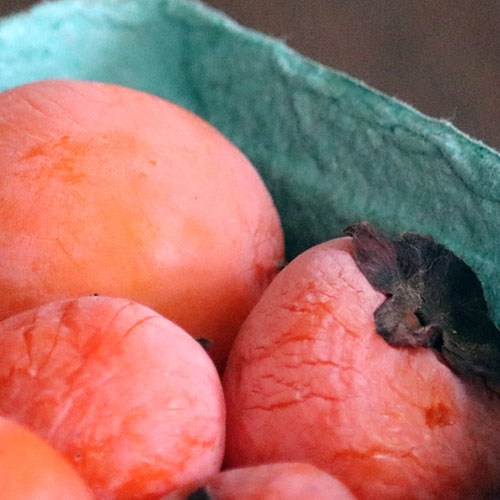Makes about 16 2-inch blondies
These are like a cross between gingerbread, persimmon pudding, and regular old blondies. They’re lightly spiced so that more persimmon flavor comes through.
Ingredients
1 cup all-purpose flour
½ tsp. cinnamon
½ tsp. ginger
½ tsp. table salt
⅛ tsp. baking soda
1 stick (8 tbsp.) unsalted butter
¾ cup dark brown sugar
1 cup American persimmon pulp, pureed or not*
2 eggs
1 tbsp. rum or bourbon** or 1 tsp. vanilla extract
Preparation
Preheat the oven to 350°F and position a rack in the center. Line an 8-by-8-inch pan with foil or parchment paper, letting several inches hang over two opposite sides to create handles. Grease the pan and foil and set aside.
In a medium bowl, whisk together the flour, cinnamon, ginger, salt, and baking soda. Set aside.
Next, brown the butter: In a medium skillet, melt the butter over medium heat. Continue cooking the butter until the foam subsides and the milk solids at the bottom of the skillet turn a toasty brown color and smell nutty. At first, the melted butter will sputter and steam. Just be patient and keep an eye on it. Once the butter is finished browning, remove the skillet from heat.
To make the batter, whisk the brown sugar and persimmon pulp together in a large bowl. Whisk in the eggs, one at a time, and then whisk in the butter. (The mixture might look curdled. That’s okay). Switch to a rubber spatula and fold in the flour mixture until the batter is smooth, with no streaks of flour.
Scrape the batter into the prepared pan and smooth the top. Bake until slightly puffed, about 25 minutes. The center should feel soft but not squishy when you press it lightly with your fingertip, and a toothpick inserted in the center should come out with some crumbs, but no wet batter.
Cool the pan on a wire rack. The blondies will collapse and pull away from the sides after a few minutes out of the oven, and the tops may seem to darken. That is normal. If you cut into these while they are warm, the blondies may have a slightly mealy texture. I prefer to refrigerate the entire pan, uncut, overnight. On the next day, they’ll be rich and fudgy. It’s worth that wait. Please trust me.
When you’re ready to cut, place a cutting board over the pan, invert it, peel off the foil or parchment, then invert the uncut blondie again and slice.
You can store these at room temperature for several days. You can also wrap these well in plastic wrap and freeze them for several months.
*If you prefer smooth blondies, puree or sieve the persimmon pulp. Blondies made with more intact persimmon pulp are laced with slightly chewy bits of the fruit, almost like fragments of tender dried apricot. I find it very appealing.
**I actually used bourbon-based sassafras bitters. So if you just happen to have bourbon-based sassafras bitters, use that.


